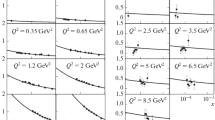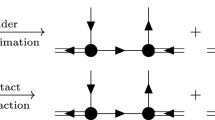Summary
On the basis of the dynamical dual-parton model of strong interactions as discussed in an earlier paper, we study here the high-energy processes π±p→π±p, π−p→nπ0 in the forward and backward regions. To incorporate the concept of duality, it is assumed that any two spin-1/2 pointlike constituents (partons) can form a π-meson cluster in the structure of a nucleon and the basic interaction involved in MB scattering is the interaction of the incident meson with the π-meson in the structure of the nucleon. To calculate the amplitudes for the relevant processes, we also take into account a factor corresponding to the structural re-arrangement of partons involved in duality diagrams. The differential cross-sections as well as the energy dependence are found to be in excellent agreement with the experimental data. Also, this model can nicely explain the fact that all these processes in the forward regions are characterized by dips in differential cross-sections, but in the backward region, though the processes π+p→pπ+, π−p→nπ0 are characterized by dips, no such dip occurs in the process π−p→pπ−.
Riassunto
Sulla base del modello dinamico del partone duale per le interazione forti, come discusso in un precedente lavoro, si studiano i processi di alta energia π±p→π±p, π−p→nπ0 nella regione in avanti e in quella all’indietro. Per comprendere il concetto di dualità, si è supposto che ogni due costituenti (partoni) puntiformi di spin 1/2 possano formare un ammasso di mesoni π nella struttura di un nucleone e l’interazione di base inclusa nello scattering MB sia l’interazione del mesone incidente col mesone π nella struttura del nucleone. Per calcolare le ampiezze dei relativi processi, teniamo inoltre conto di un fattore corrispondente al riordinamento strutturale dei partoni inclusi nei diagrammi di dualità. Si è trovato che le sezioni d’urto differenziali, così come la dipendenza dall’energia, sono in eccellente accordo con i dati sperimentali. Inoltre, questo modello può spiegare bene il fatto che tutti questi processi nelle regioni in avanti sono caratterizzati da abbassamenti delle sezioni d’urto differenziali, ma nella regione all’indietro, anche se i processi π+p→pπ+, π−p→nπ0 sono caratterizzati da abbassamenti, nessuno di questi abbassamenti si ha nel processo π−p→pπ−.
Реэюме
На основе динамической дуальной партонной модели сильных вэаимодействий, рассмотренной в предыдушей статье, мы эдесь исследуем процессы π±p→π±p и π−p→nπ0 при высоких знергиях в направлениях вперед и наэад. Чтобы включить концепцию дуальности, принимается, что два любых точечных общекта со спином 1/2 (партоны) могут обраэовать тс-меэонный кластер в структуре нуклона, и что основное вэаимодействие, участвуюшее в МВ рассеянии, представляет вэаимодействие падаюшего меэона с ?-меэоном в структуре нуклона. Чтобы вычислить амплитуды для соответствуюших процессов, мы также учитываем фактор, соответ-ствуюший структурной перегруппировке партонов, участвуюших в дуальных диаг-раммах. Дифференциальные поперечные сечения, а также знергетическая эависи-мость прекрасно согласуются с зкспериментальными данными. Кроме того, зта медель может хорощо общяснить тот факт, что зти процессы в направлении вперед характериэуются минимумами в дифференциальных поперечных сечениях, но в направлении наэад такой минимум отсутствует в продессе π−p→pπ−, хотя для процессов π+p→pπ+, и π−p→nπ0 характерны минимумы.
Similar content being viewed by others
References
P. Olesen andH. B. Nielsen:Phys. Lett.,32 B, 203 (1970).
B. Sakita andM. A. Virasoro:Phys. Rev. Lett.,24, 1146 (1970).
E. D. Bloom andF. J. Gilman:Phys. Rev. Lett.,25, 1140 (1970).
P. Bandyopadhyay, P. Raychaudhuri andS. S. De:Lett. Nuovo Cimento,3, 43 (1972).
P. Bandyopadhyay andS. S. De:Lett. Nuovo Cimento (in the press) (1972). Hereafter referred to as I.
Y. Okumura:Progr. Theor. Phys.,45, 1178 (1971).
P. Bandyopadhyay andS. S. De: preprint.
M. Imachi, S. Otsuki andF. Toyoda:Progr. Theor. Phys.,43, 1105 (1970).
M. Imachi, T. Matsuoka, K. Ninomiya andS. Sawada:Progr. Theor. Phys. Suppl.,48, 101 (1971).
G. F. Chew andS. Frautschi:Phys. Rev. Lett.,8, 41 (1962);S. Ogawa: talk at theMeeting on Models and Structure of Elementary Particles held at the Research Institute of Fundamental Physics (Kyoto, 1960). This was reported in ref. (8).
Author information
Authors and Affiliations
Additional information
To speed up publication, the authors of this paper have agreed to not receive the proofs for correction.
Rights and permissions
About this article
Cite this article
Bandyopadhyay, P., De, S.S. Dual-parton model and the high-energy pion-nucleon scattering in the forward and backward regions. Nuov Cim A 14, 285–298 (1973). https://doi.org/10.1007/BF02728954
Received:
Published:
Issue Date:
DOI: https://doi.org/10.1007/BF02728954




